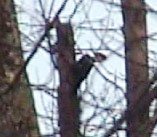Snowy, I don't think I'm seeing what you're seeing. To the extent that there's spreading out, it looks more like an artifact of blur and angle to me, contrast with some of the earlier frames that are straight silohuette. Hope I'm counting correctly.
Snowy1 said:2) Frame 70: the crest seems very disorganized and spread out, something I've seen regularly on a Pileated but from the few reference photos of IBWO, I haven't seen. Again, I'm not sure if that's worth mentioning as a "field mark"




